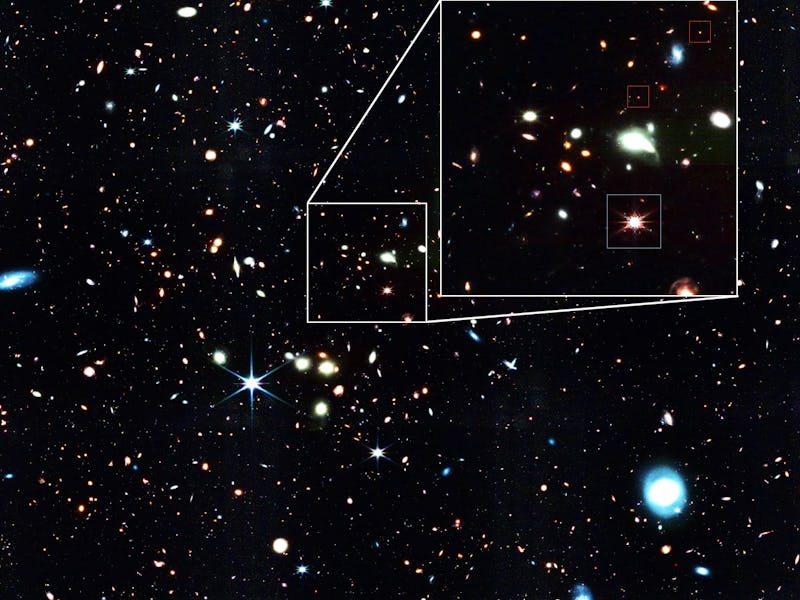“Something doesn’t add up”: The Webb Telescope Identified Premature Supermassive Back Holes
These objects could shed light on how supermassive black holes evolve — and where they came from in the first place.

A team of astronomers recently discovered that little red dots in the distant universe were actually baby quasars, the precursors to the supermassive black holes at the center of galaxies like our Milky Way. Astrophysicist Jorryt Matthee, of Austria’s Institute of Science and Technology, and his colleagues published their work in The Astrophysical Journal.
The small orange-red objects with the six refraction spikes are small, early galaxies with actively-feeding supermassive black holes, about 13 billion light years away.
Connecting the Dots
Matthee and his colleagues used the James Webb Space Telescope (JWST) to peer deep into a tiny slice of the sky. In older images from the Hubble Space Telescope, the faint red dots in the cosmic distance (13 billion light years away) had looked like very ancient, but otherwise ordinary, galaxies. However, JWST’s instruments picked up something else: specific wavelengths of light associated with hot, fast-moving hydrogen.
“These spectra tell us that we are looking at a very small gas cloud that moves extremely rapidly and orbits something very massive, like a supermassive black hole,” says Matthee in a recent statement.
The supermassive black holes in these “little red dot” galaxies are small: about 10 to 100 million times more massive than our Sun, which is tiny for a supermassive black hole. And if Matthee is right, they’re still young.
“My intuition says these are fairly young systems of maximally a few hundred million years old that are rapidly evolving (at least, on "astronomical timescales" of millions of years),” Matthee tells Inverse. To be sure about that, he and his colleagues will need to measure the ages of the stars around the black holes. Meanwhile, these “little red dots” look like small, early versions of the type of supermassive black holes that Matthee calls “problematic quasars.” (A quasar is an actively-feeding supermassive black hole at the center of a galaxy.)
Sometimes Space is Problematic
Matthee’s problematic quasars are problematic because they’re too big to exist where and when they exist: between 11 and 12 billion light years away, when the universe was just a couple of billion years old. If supermassive black holes formed the way astrophysicists have long assumed — starting with a giant star collapsing into a black hole, then growing larger as it pulls in more material — then black holes that are billions of times more massive than our Sun shouldn’t have existed 11 billion years ago. Black holes that started as 30 times our Sun’s mass shouldn’t have had time to grow so large in less than a couple of billion years.
“It’s like looking at a 5-year-old child that is 2 meters tall,” says Matthee. “Something doesn’t add up.”
And yet there they are. Earlier this year, a team of astronomers announced that they had spotted a supermassive black hole about the same mass as the behemoth at the center of the Milky Way – dating to 13.4 billion years ago.
So either black holes grow faster than the laws of physics suggest they do, or they started as something more massive than an ordinary collapsed star. One possibility is that the “seeds” of supermassive black holes were already thousands of times our Sun’s mass, spawned by enormous clouds of gas collapsing under their gravity.
Much of what JWST has revealed about the early universe seems to support the idea that supermassive black holes formed from more massive “seeds,” not ordinary collapsed stars, but there’s not enough evidence yet to settle the debate.
“In my view, we currently can not yet discriminate between these scenarios,” Matthee tells Inverse.
What’s Next?
To do that, astrophysicists will need more data. Matthee and his team want to measure the conditions in which these early black holes formed: the mass of the stars in their host galaxies, the amount of heavy elements in the galaxy’s ingredients list, and whether there’s galactic wind. They’re also curious about whether these precociously-large supermassive black holes tend to form in galaxy clusters or less-populated cosmic neighborhoods.
Over the next couple of years, Matthee and his team have booked more time on JWST, which they’ll use to search for more “little red dots” even farther away — and farther back in time.
“We want to extend the population of ‘baby quasars’ that we know of,” says Matthee. “By finding new ones even earlier in time, we should witness them closer to their birth, meaning we can learn more about their formation conditions. The same may be learned by finding even lower mass supermassive black holes, with masses ~100,000-1,000,000 times the Sun, and characterizing the properties of the galaxies they formed in.”